You may not find this terribly rewarding unless you're included here, so this is a good time for casual and random browsers to turn back before they get too caught up in the sweep and majesty of the proceedings and can't let go.
There was a time when we could leap into the car and drive an hour over the Grand Saint Bernard for another visit to Italy -- 3, 4, 5 times a year. These days it's a lot more complicated, and more expensive, of course.
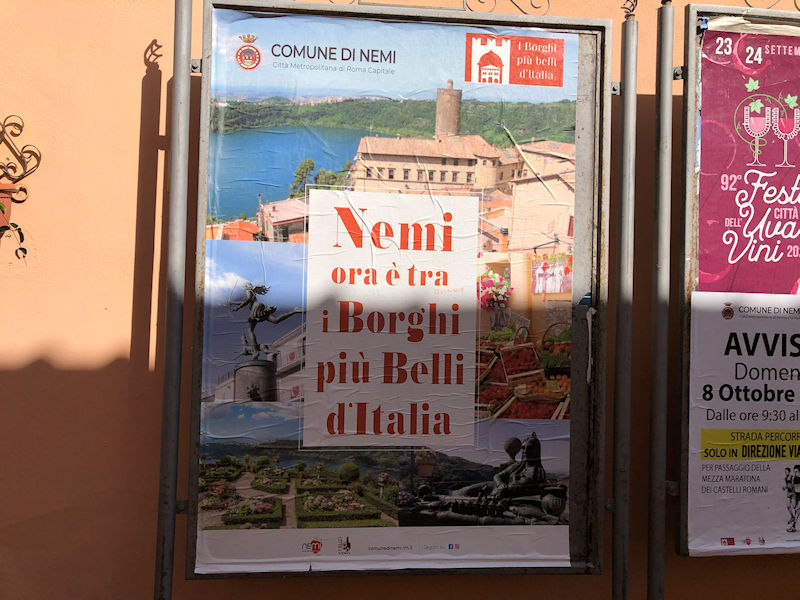
The comune of Nemi, with its ca. 2,000 inhabitants, is perched on a cliff on the northeastern rim of the Nemi Lake, and as the sign justifiably boasts, it's listed as one of the Most Beautiful Towns in Italy. (So is Castel Gandolfo, by the way.) The lake is just a mile and a half southeast of the Lago Albano, similarly formed by a volcanic crater.
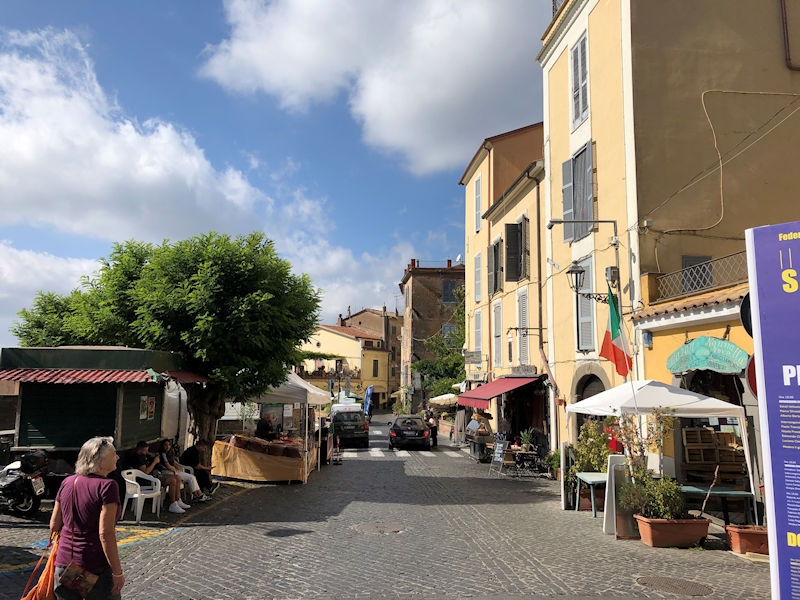
The town's name derives from the Latin word for 'Holy Wood', as the lake was the site of a sacred grove dedicated to the goddess Diana as early as the 6th century BC. It became a famous cult site especially with the erection in about 300 BC of a 'Temple of Diana Nemorensis' on the lake shore beneath the present town, which was only abandoned sometime in the late Roman Empire. It was rediscovered in the 1600s and amateur archaeologists over time have carried off 'statues of splendid workmanship' now in museums all round Europe and the USA.
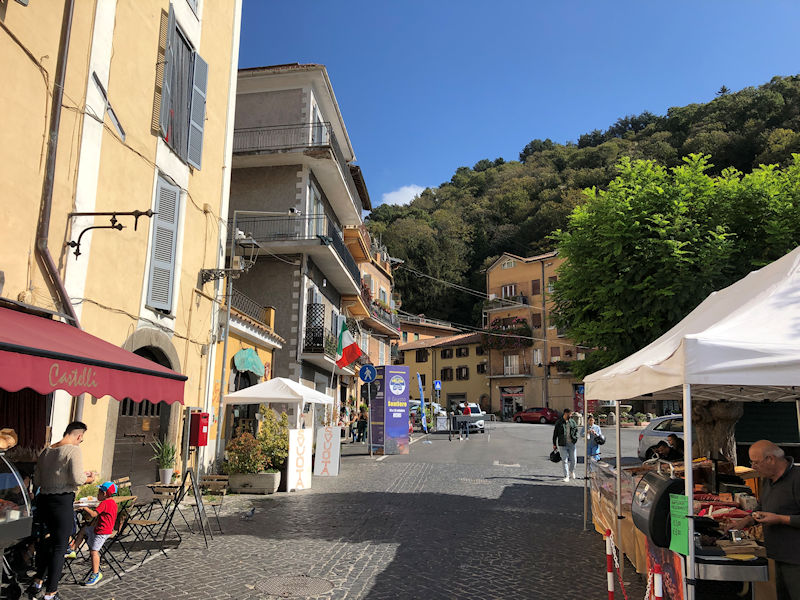
This is the main drag through the town centre, the Corso Vittorio Emanuele. Much of the architecture at this end of the village looks 18th and 19th century, but we're told that there are a few late medieval to 18th‑century churches.
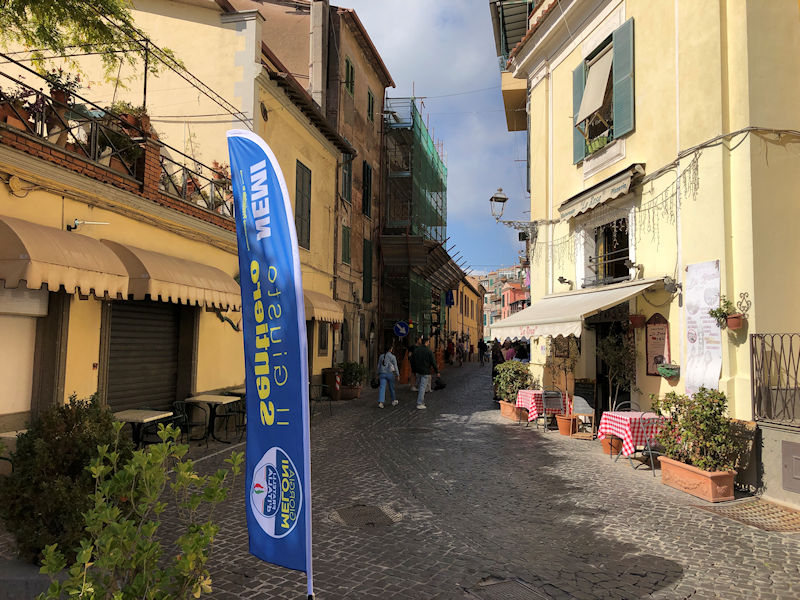
The flaggy sort of thing announces 'The Right Path' -- a meeting or event of some kind apparently scheduled here for later today.
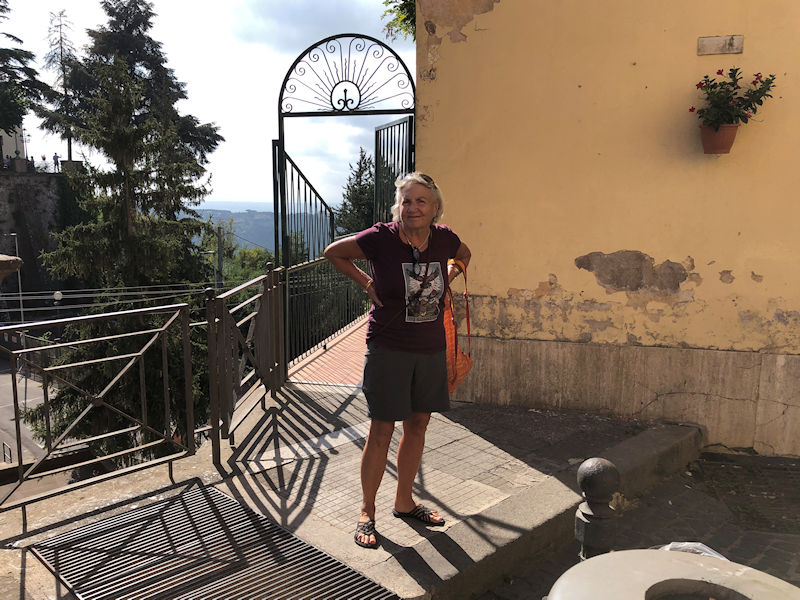
A member of our party exulting in the scenery and ambience
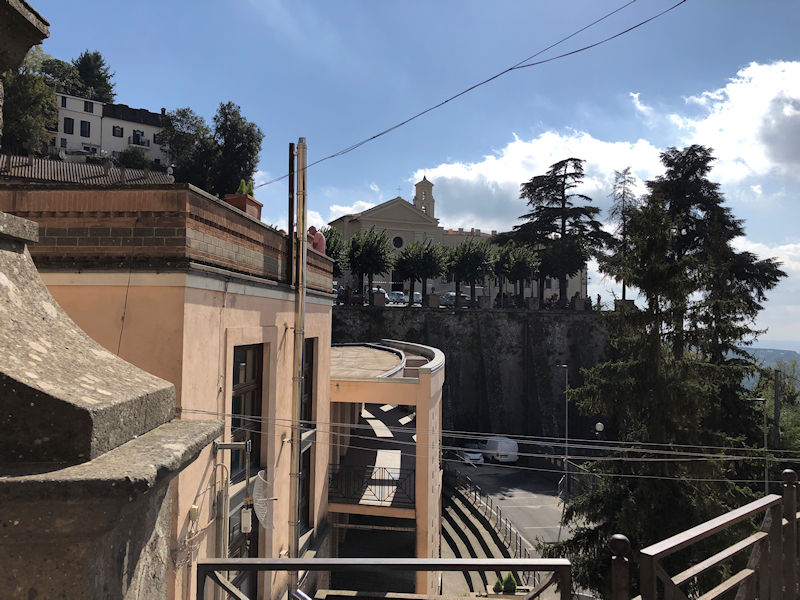
Looking across at a church just over the way; perhaps we'll go have a look later.
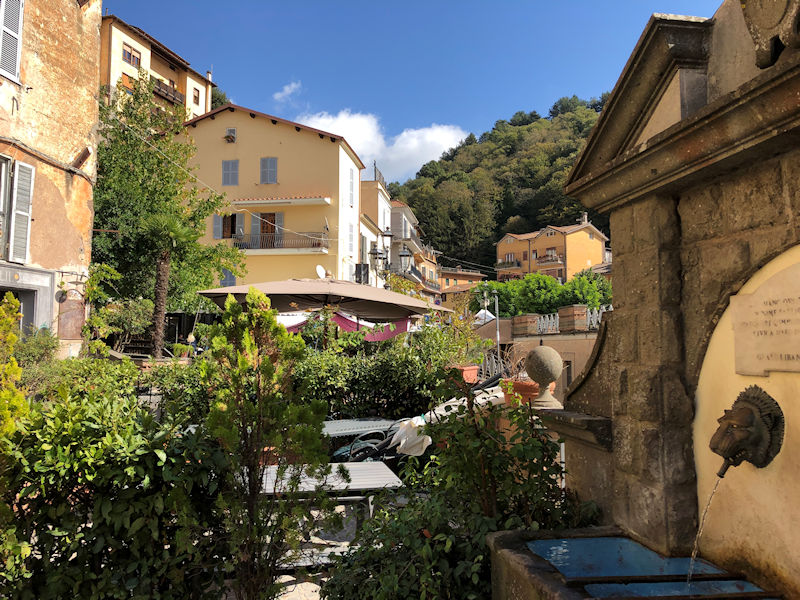
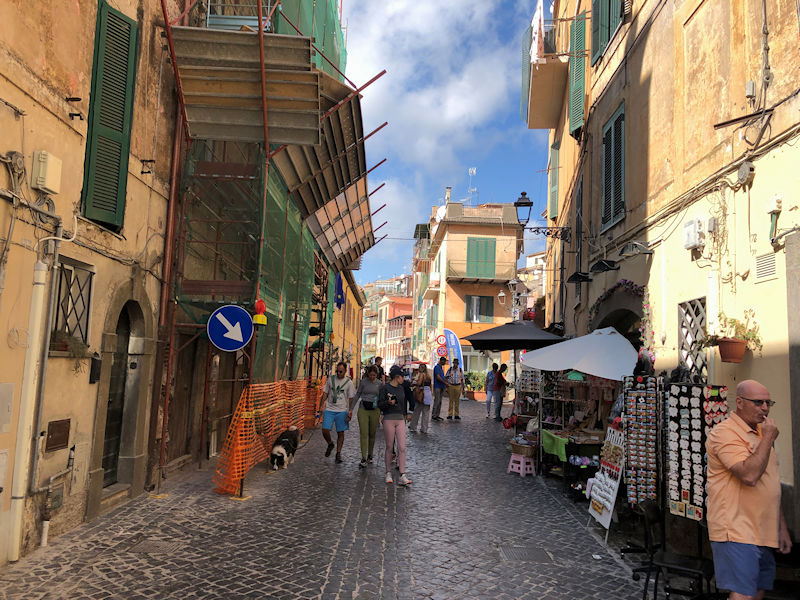
Street scene
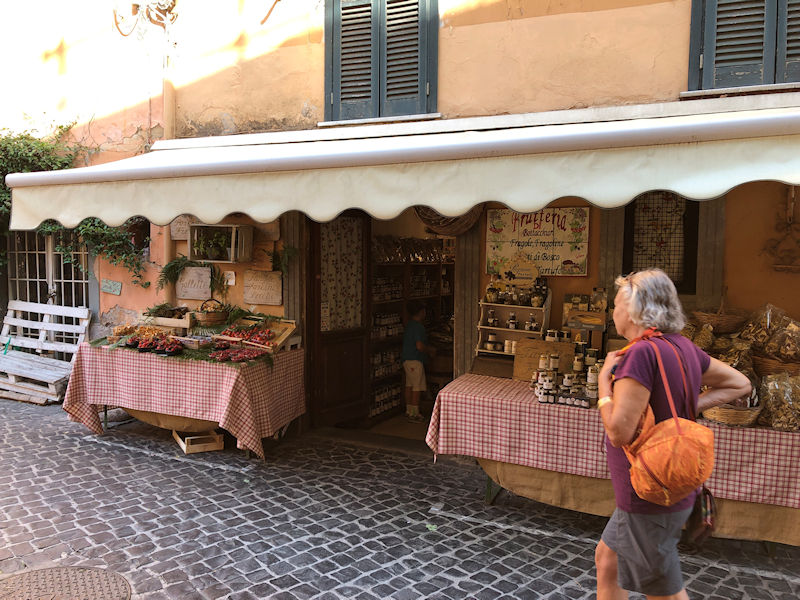
Note the wild strawberries on display -- Nemi is especially famous for them.
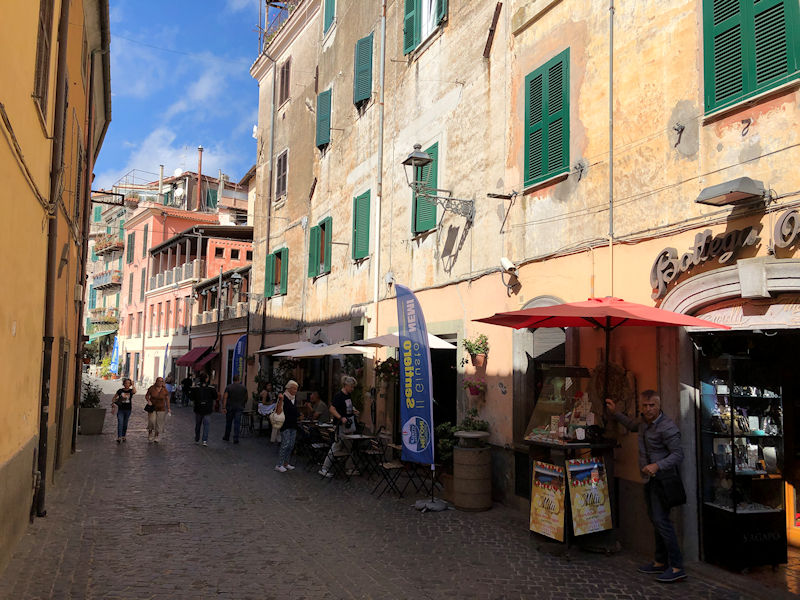
More 'Right Path' decorations (what's really going on here?)
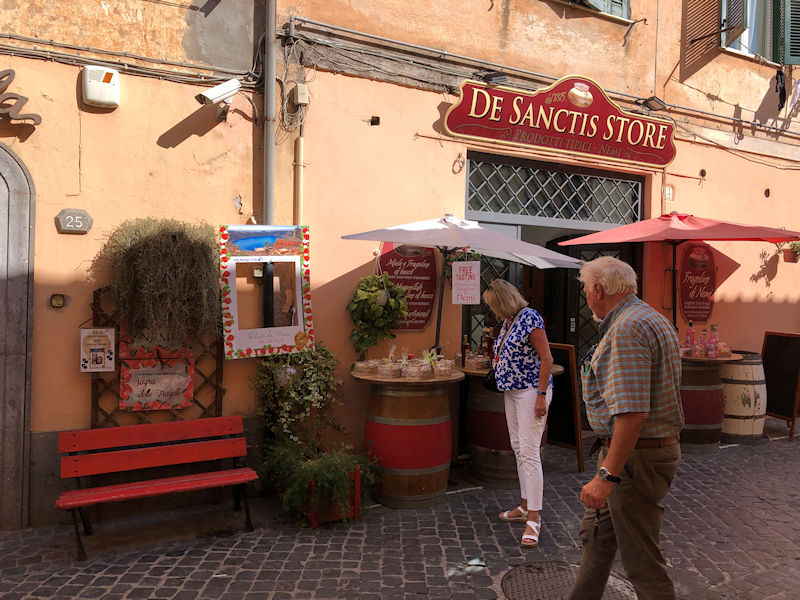
'Typical products of Nemi'
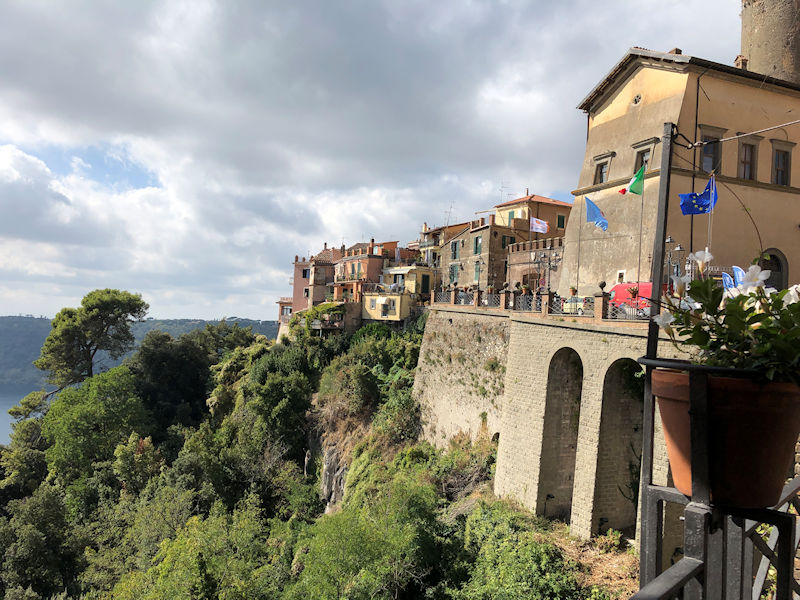
The view out to the far end of the town, with the Palazzo Ruspoli and its Saracen Tower looming.

Overlooking the lake. There isn't very much down there, town-wise, but odds and ends like a ship museum, some archaeological stuff, etc.
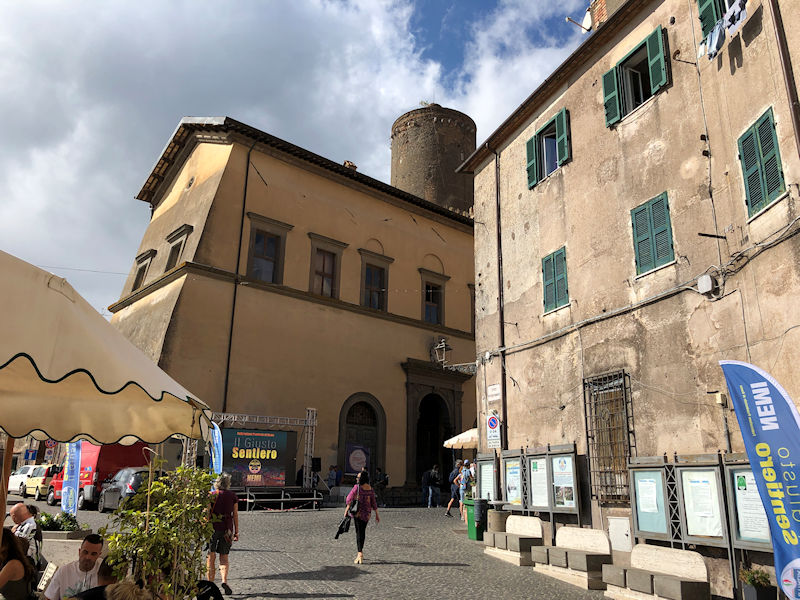
The Piazza Umberto I is as the heart of the historical town -- the tower above, called the Saracen Tower, was built in the 9th and 10th centuries (Saracen raiding days!), and the medieval castle, belonging to the Counts of Tusculum, grew up around it beginning in the 12th century. It was occupied in 1572 by the Frangipane family of Rome, who converted it over time from a small fortress into the present palace.
The complex passed through the hands of many well-known families, like the Annibaldi, Colonna, Cenci, and Orsini, but in 1993 the last noble owners, the Ruspolis, sold it off, and it's still known as the Palazzo Ruspoli.
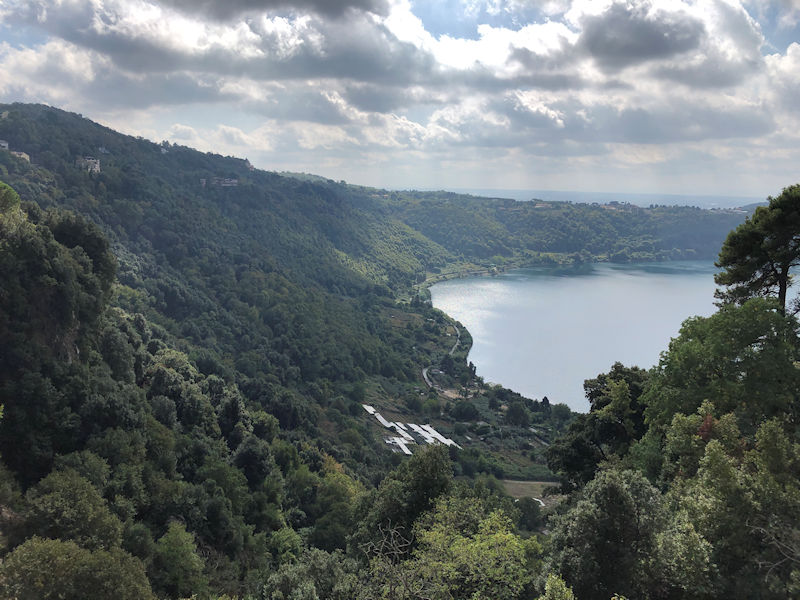
There's not very much going on down along the lake shore -- ruins of the Diana temple, a beach evidently, and a Museum of the Roman Ships. The Roman emperor Tiberius and other patricians had been coming to Nemi for its cooler air in summer and its religious associations, but the emperor Caligula (r. AD 37-41) built two enormous party ships on the lake (both over 70 meters long). They were deliberately scuttled after Caligula's assassination and damnatio memoriae and forgotten for centuries, but in the mid-15th century Cardinal Prospero Colonna learned of local fishermen's reports and in 1446 commissioned Leon Battista Alberti to try to salvage them. Alberti was able to bring up only a few interesting bits.
Further attempts were made over the years, including by using a primitive diving bell in 1535 and more promisingly in 1895, but there was better luck when Mussolini took the matter in hand in 1929. In both lakes Albano and Nemi, in the 4th century BC 'emissaries' had been dug out, subterranean tunnels through the volcanic rims to allow for control of the variable water levels in the lakes, and this time the 1,650m Nemi tunnel was used to drop the level down to expose the ships. The ships and their amazing artifacts were then carefully salvaged and set up in a museum, opened to the public in April 1939. Unfortunately, they were mostly destroyed by a fire in May 1944, presumably but not definitely set by the retreating German army. The surviving two hulls can apparently still be seen in the present museum, and some other surviving bits in the Museo Nazionale Romano in Rome.
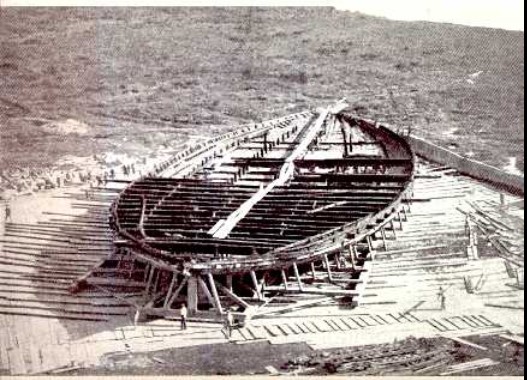
{'The remains of the hull of one of the two ships recovered from Lake Nemi. Workers in the foreground give an indication of scale. 1930' -- courtesy of Wikipedia}
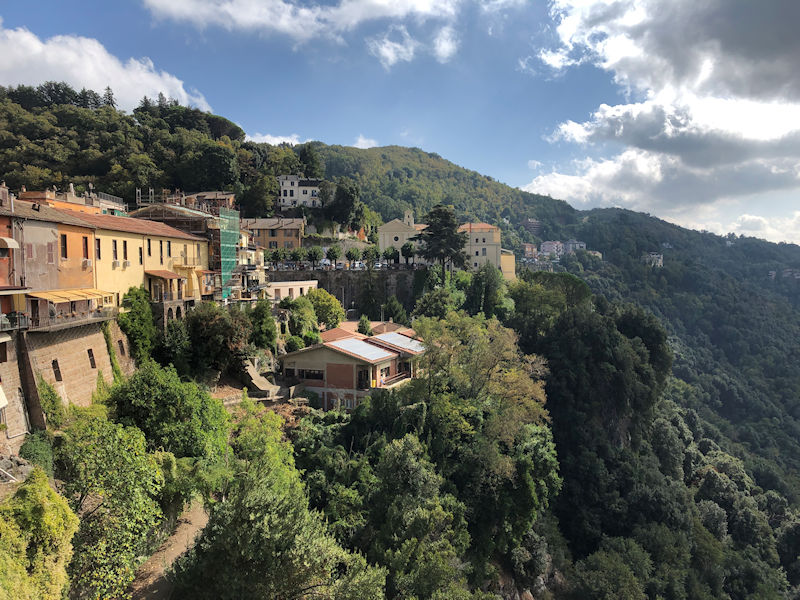
The cliff upon which Nemi perches
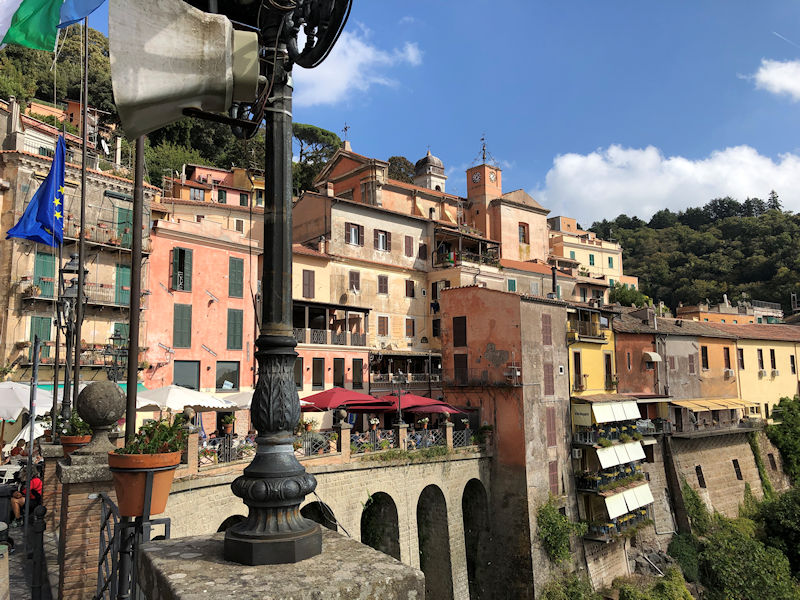
From the piazza in front of the Palazzo Ruspoli
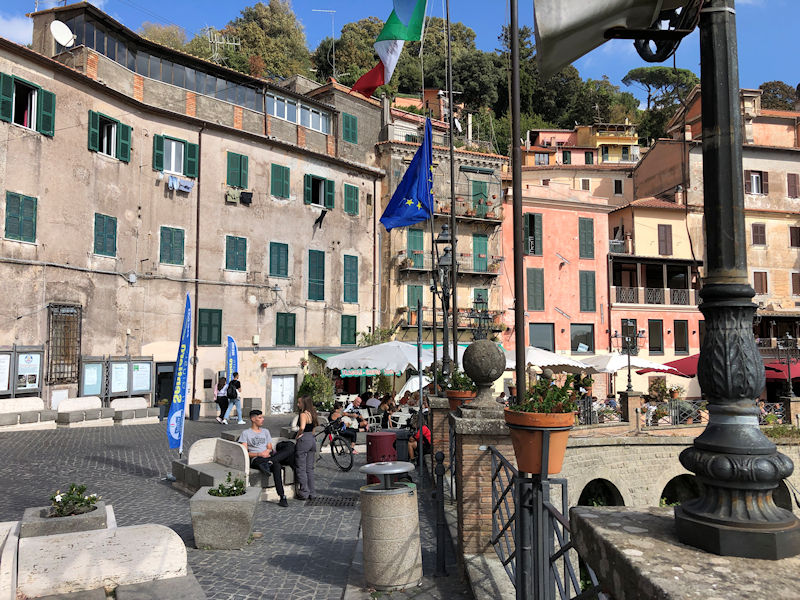
Ditto

Double ditto
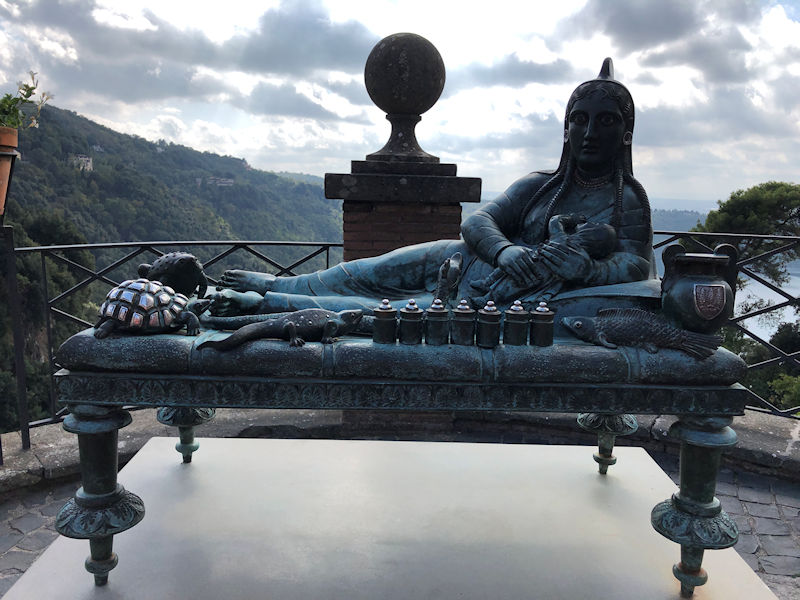
Huh?
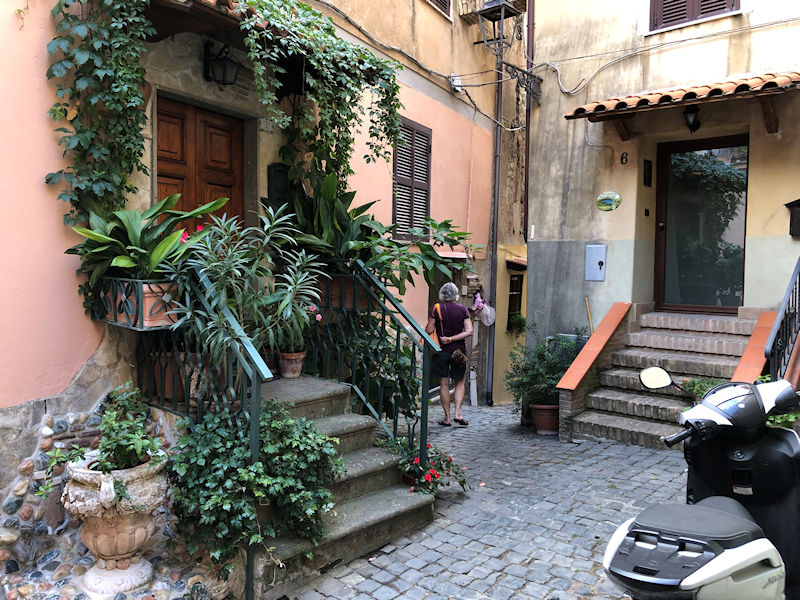
This is a casual exploration of the little dead-end neighborhood on the far side of the Ruspoli palace.

The so-called Saracen Tower from the far side
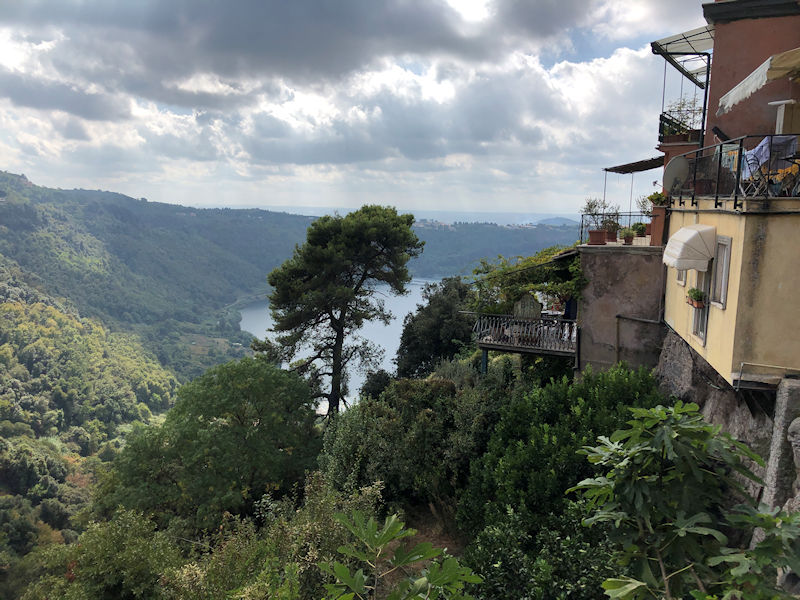

Street scene
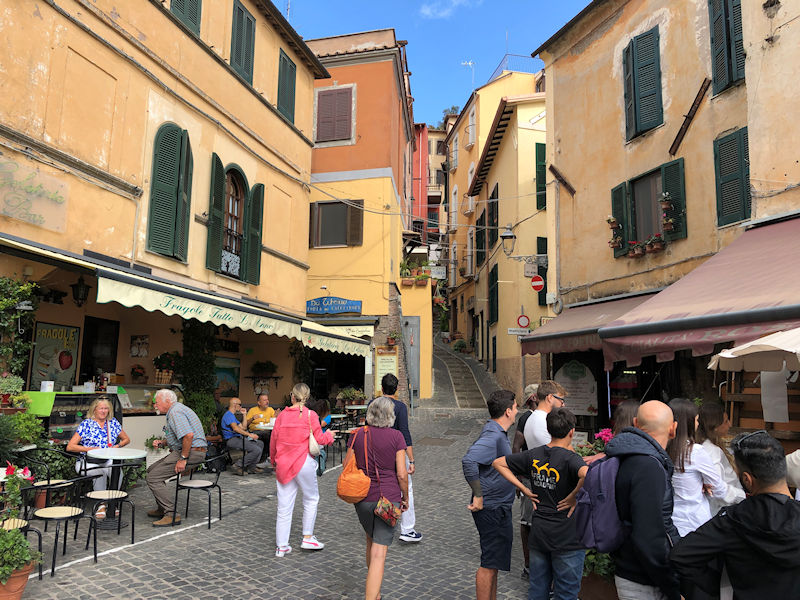
The lunch line looks a little crowded at the porchetta sandwich stand . . . we'll wander round a little more and come back.
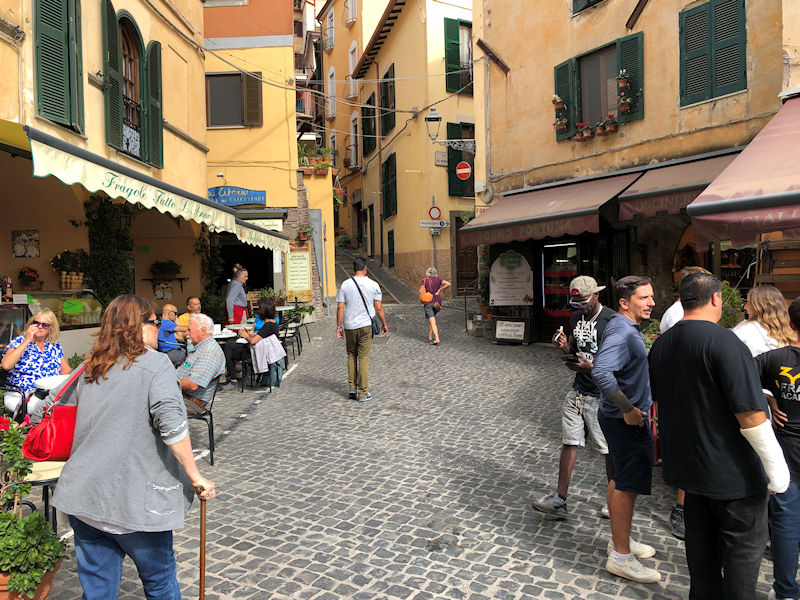
We'll need to scurry to keep up, apparently.

-- Oh man, not that way, please . . .
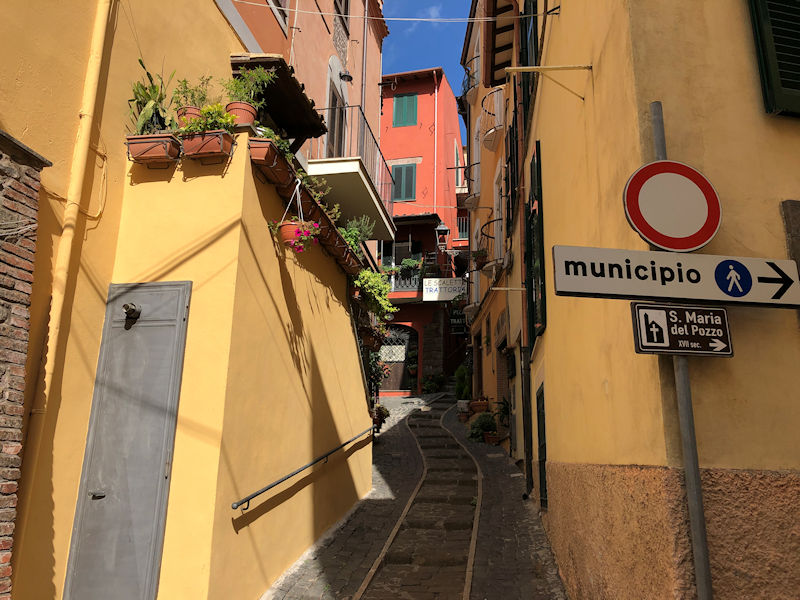
Here, up to the right -- to the Santa Maria del Pozzo! (And the municipal building)
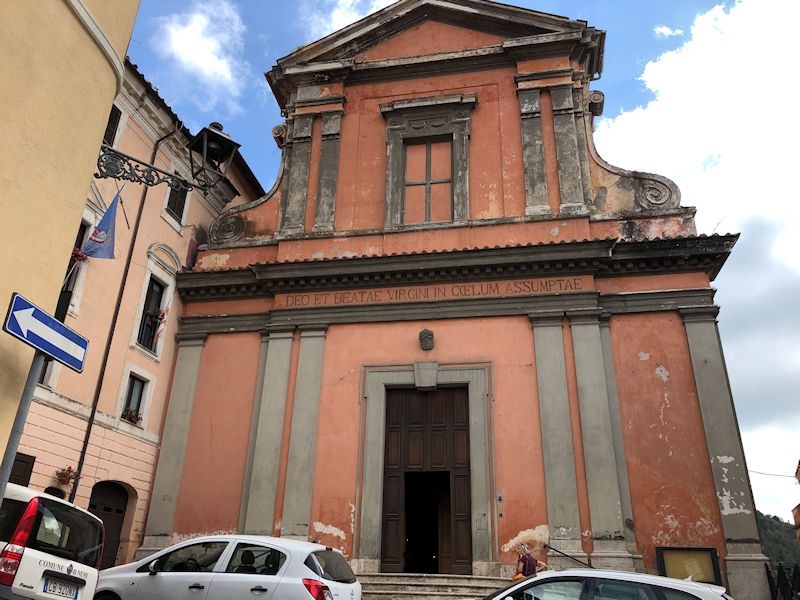
Here's the 17th century Santa Maria del Pozzo, featuring as a bonus, the Confraternity of the SS. Sacramento and the Five Wounds.
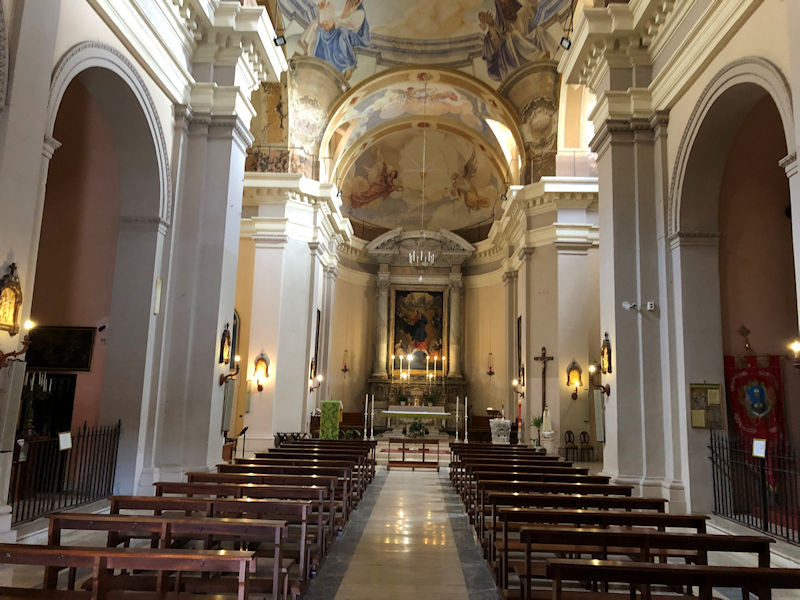
The outside looked more promising, but okay . . .
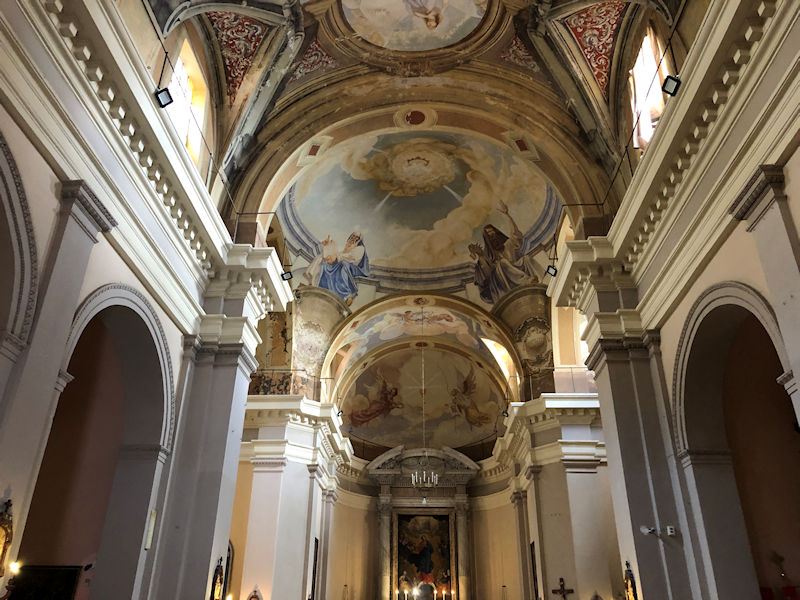
Well, we shan't tarry. The rest of our party was understandably impatient, and . . .
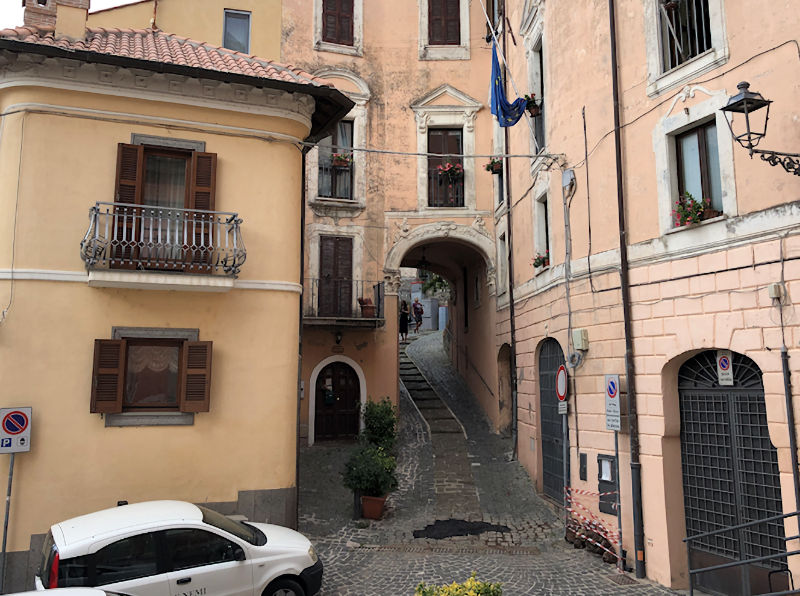
. . . is gesticulating for us to get a move on . . .

. . . but not waiting. Such determination!

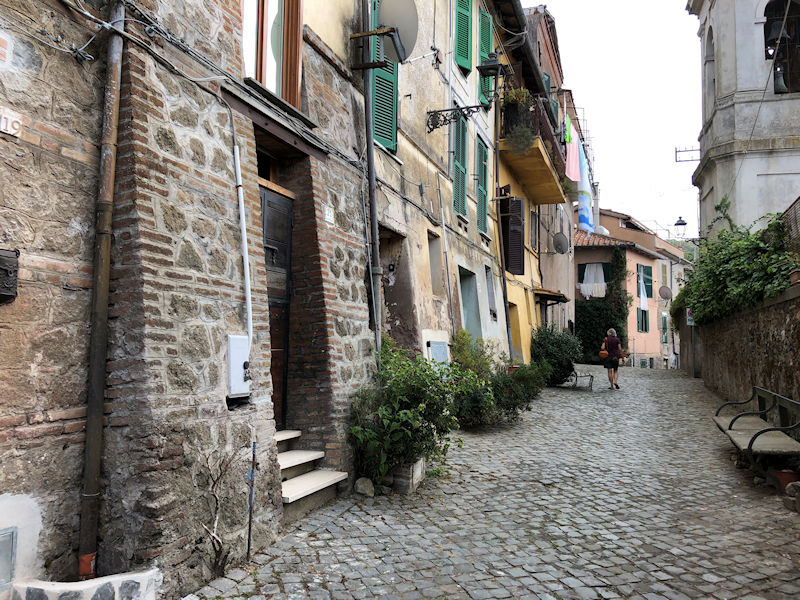
All very charming, but practical? How about getting the week's groceries up here.
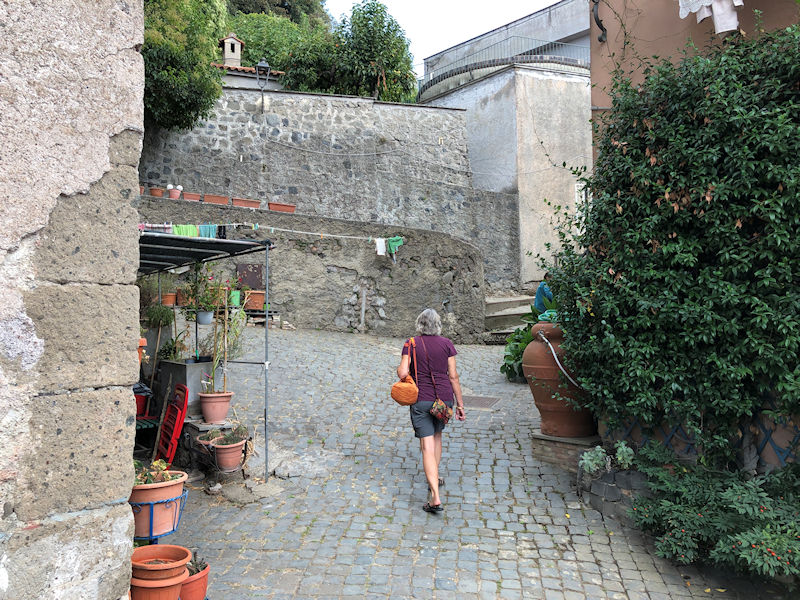
Ever upward

-- Are you ready for this?
-- Sure! Carry on.
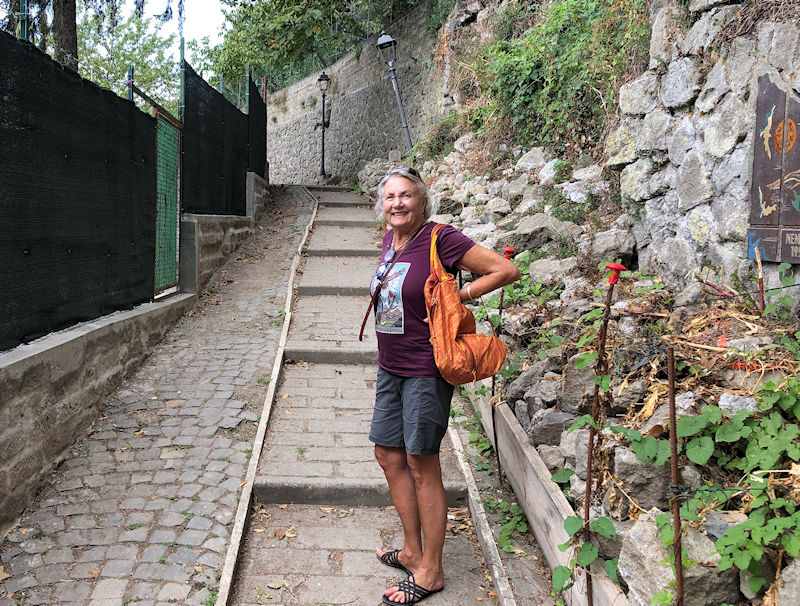
-- Fun, yeah?
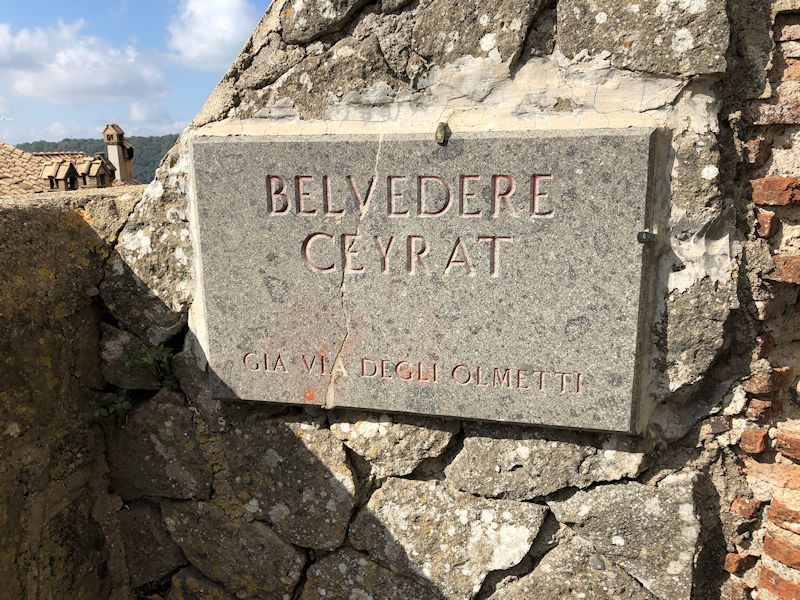
Here we are at the Belvedere at the top of the village. A young couple canoodling on a bench nearby asked us how to find the way back down.
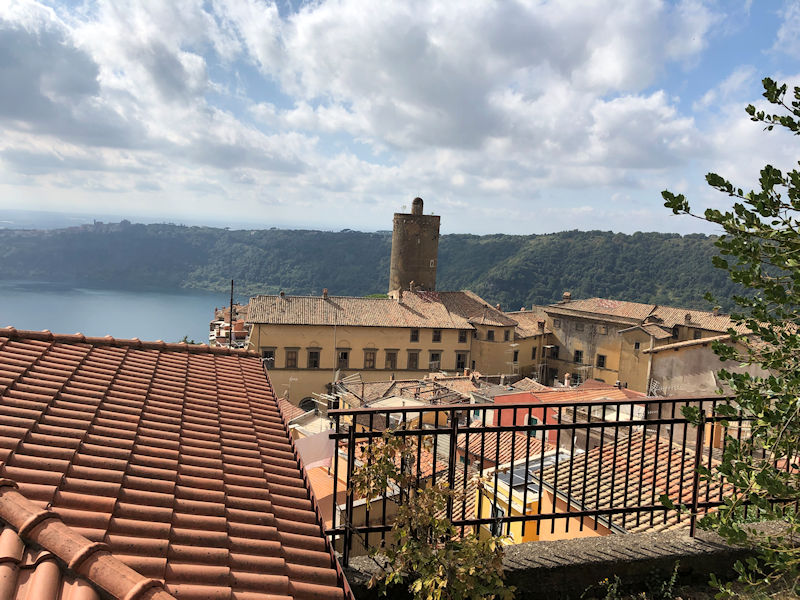
Nice view of the palace and tower, and . . .
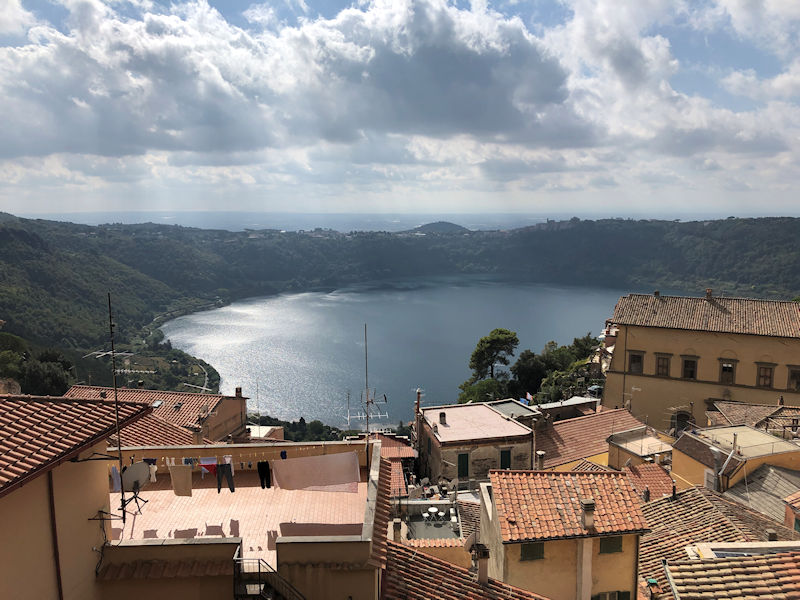
. . . especially of the little lake. In ancient times it was also called Speculum Dianae, 'Diana's Mirror'.
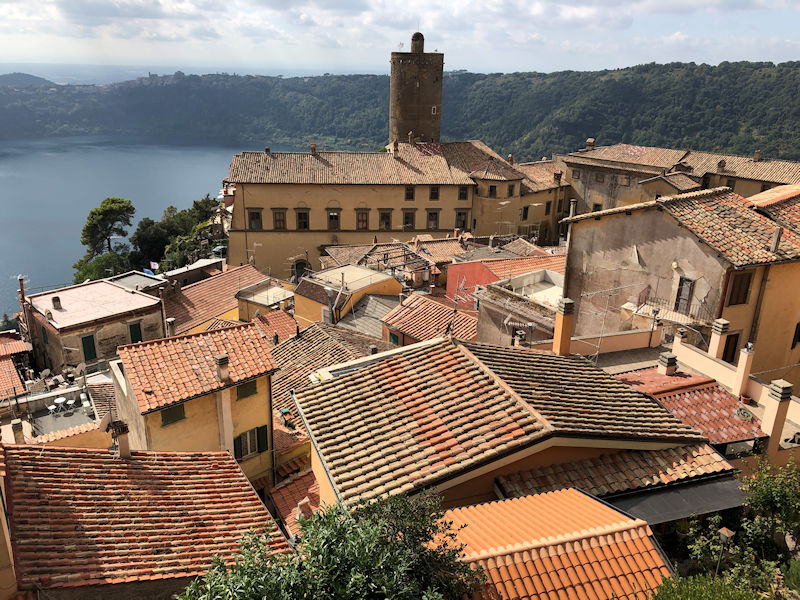
Time to go down and get lunch
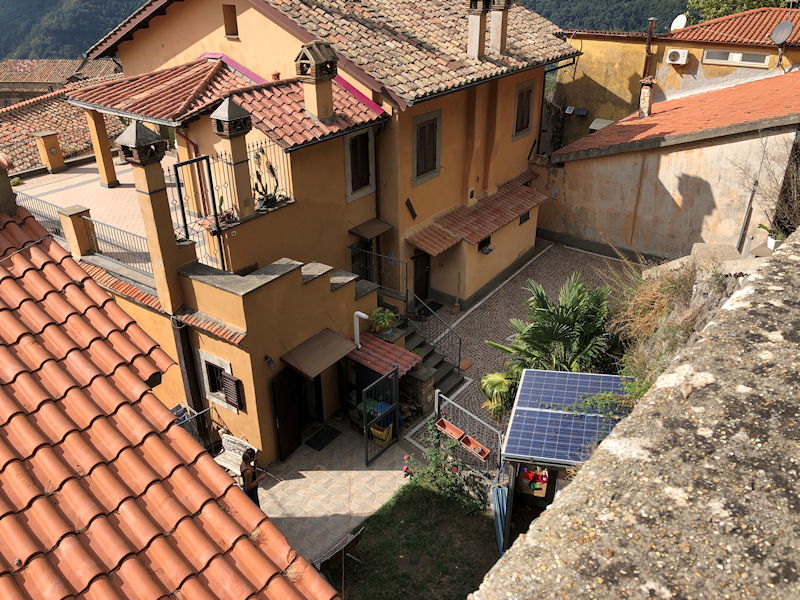
Precipitously down, in fact
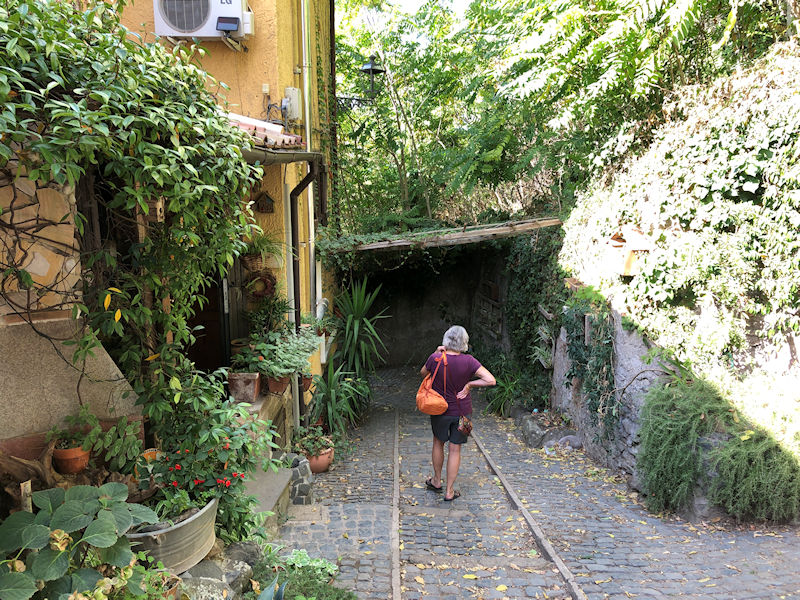
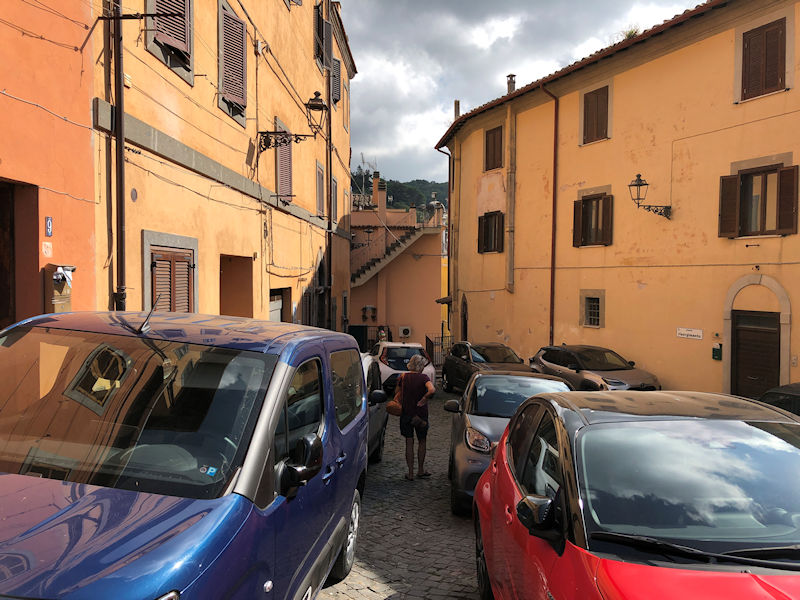
An awkward place to own a car
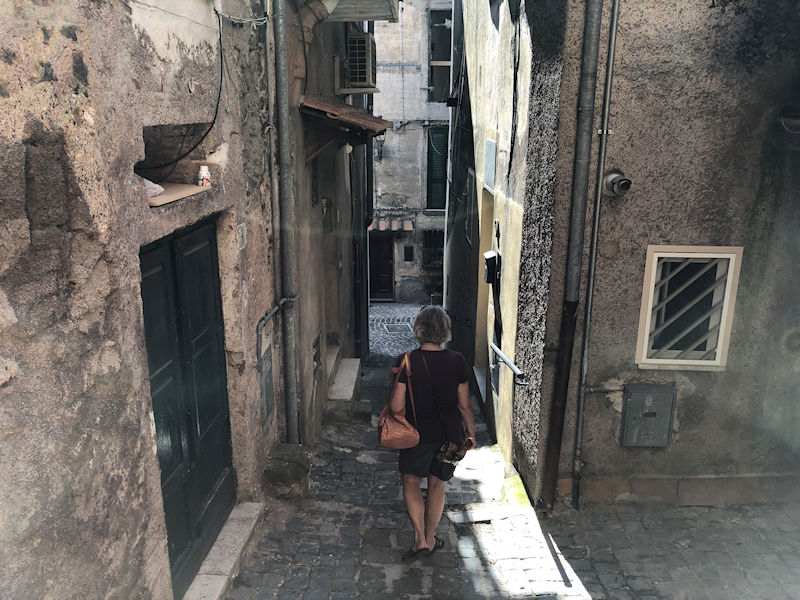

'Strawberries all the year round'
(actually we're lined up across the square waiting at the porchetta sandwich stand)

Europe's verson of 'George Washington slept here'
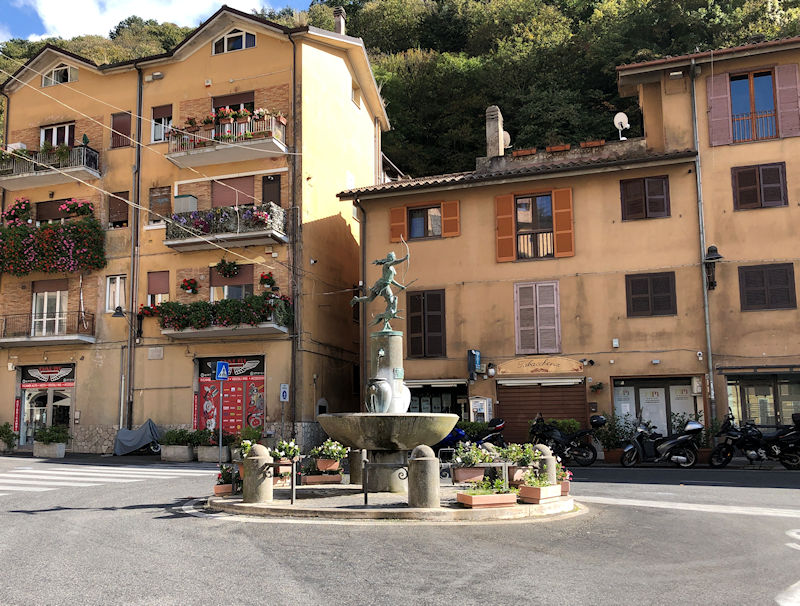
We're off for a walk out the far end of town, to see what's what. This is the piazza we pass through when entering town down the hill from the left, and that's called the 'Fontana della Dea Diana'.
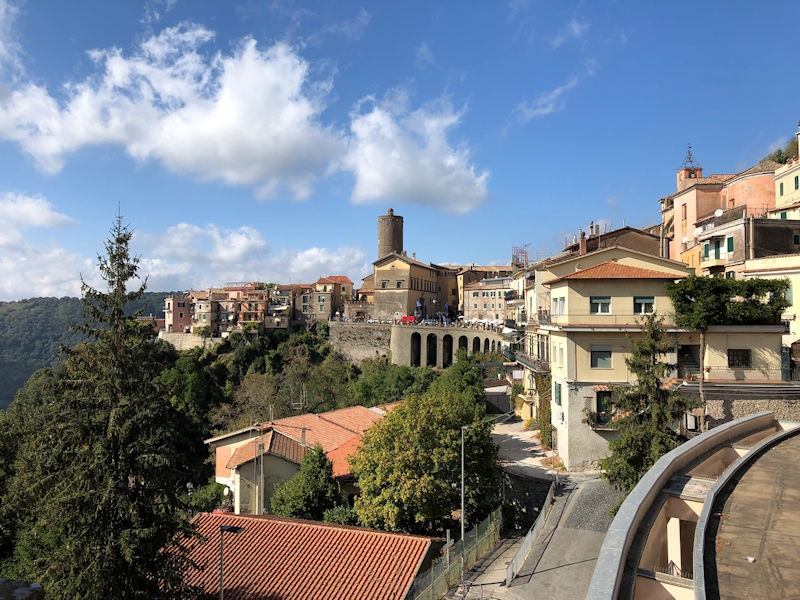
Nemi from the carpark stretching out from the Diana monument along the Via Nemorense. Directly below, on the right, is the home of Taekwondo Kickboxing Nemi. At the end of the parking lot, we come to . . .

. . . the Santuario del Santissimo Crocifisso, commissioned by the Marquis Frangipane in 1637. The rest of our party can't be distracted by a merely 17th century church, but we'll sneak in for a hasty look.

Oh well . . . probably beloved by some of the populace.
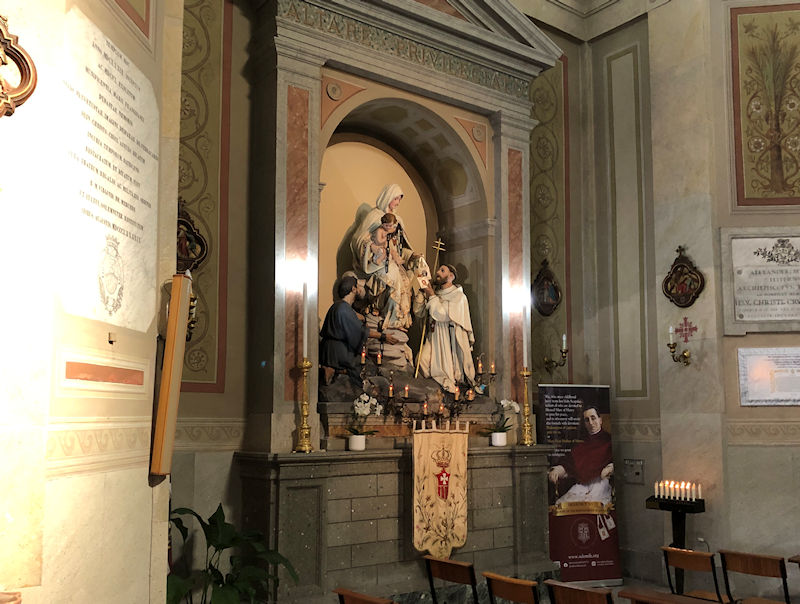
Okay, it's time to dash out and make up for lost ground on our walk.
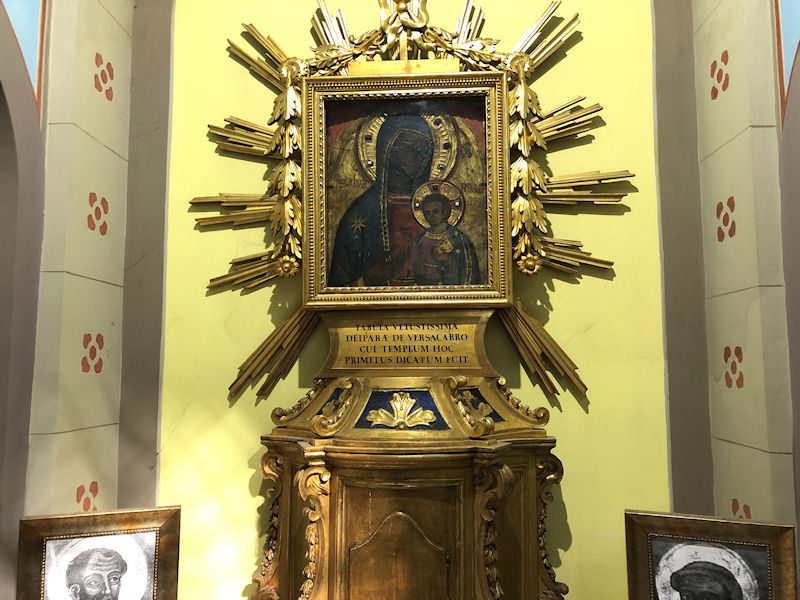
But this is something else, and justifies a few more moments of appreciation.
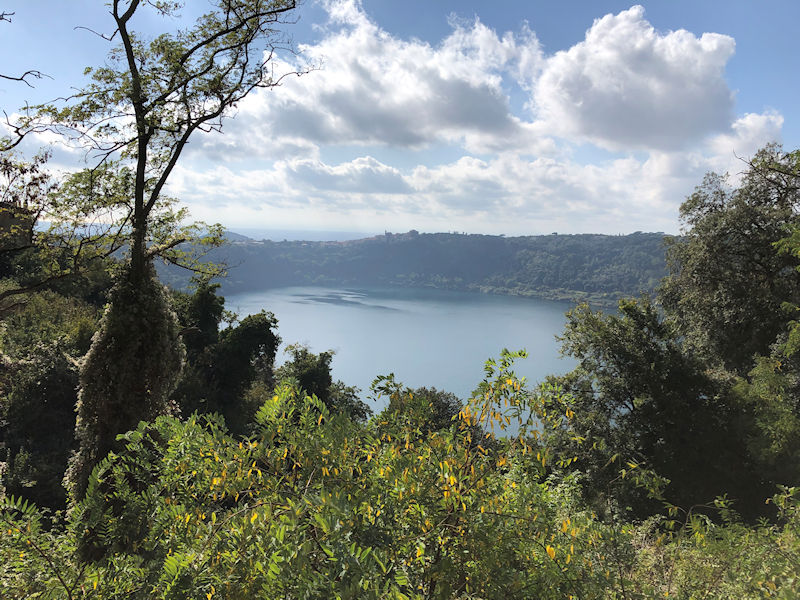
Another view of the lake, this time from a ways out the Via Nemorense
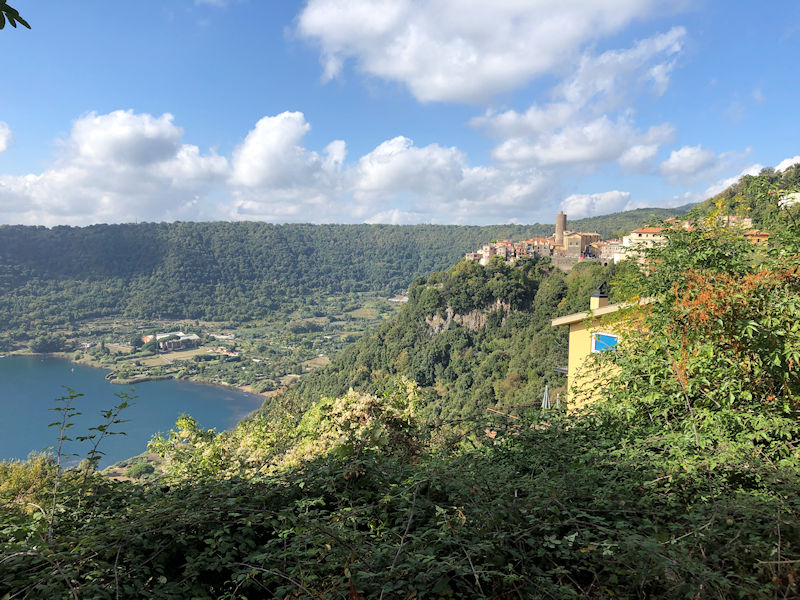
That must be the Roman Ship Museum down on the flat below. There's also the archaeological site of the Santuario di Diana Nemorense.

The Branch of Gold -- what's that all about then?
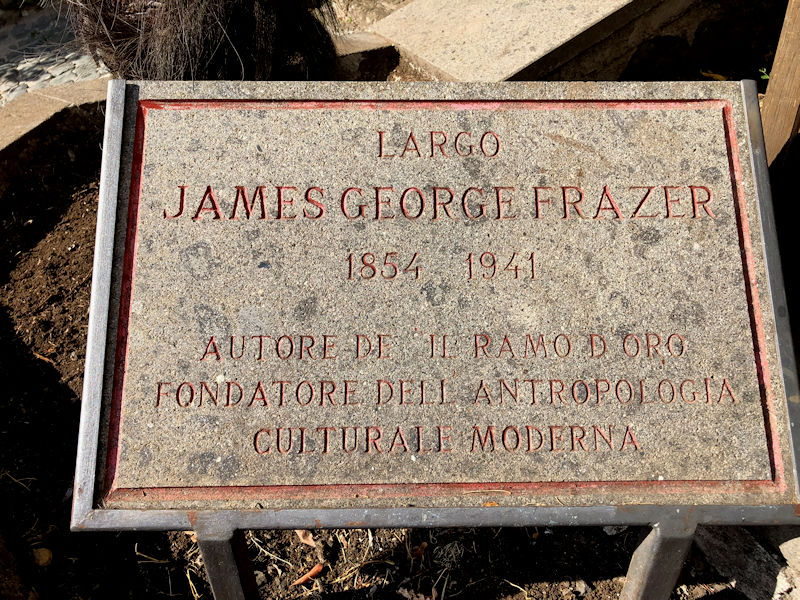
Well, there you are. Not the 'Branch', it's The Golden Bough.
Sir James George Frazer, the Scottish social anthropologist and folklorist, is considered to have pioneered the study of mythology and comparative religion. His Golden Bough on prehistoric myths and rituals was first published in 1890, with a 12-volume third edition in 1915 (I've only read the 1922 single-volume abridged edition). His theories, especially on the universal symbolic cycle of life, death and rebirth, which have not been borne out by late 20th century scholarship, nonetheless influenced many cultural giants of the time, notably Freud, and especially T. S. Eliot's The Waste Land (1922), Joseph Campbell, Mircea Eliade, and Jessie Weston's From Ritual to Romance (1920).
The connection with Nemi may seem a bit opaque, but the modern Romanist Mary Beard wrote "For those who see Frazer's work as the start of anthropological study in its modern sense, the site and the cult of Nemi must hold a particular place: This colourful but minor backwater of Roman religion marks the source of the discipline of Social anthropology". So there's that.
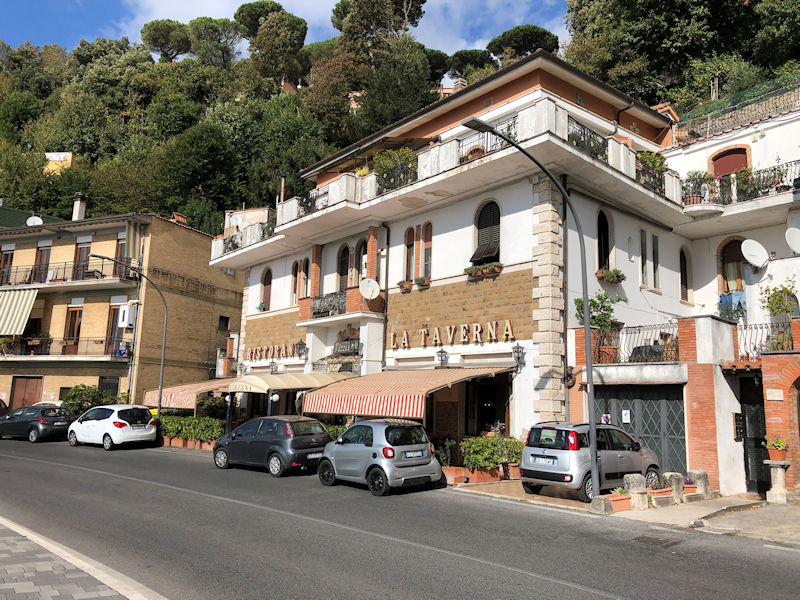
Hiking back into town
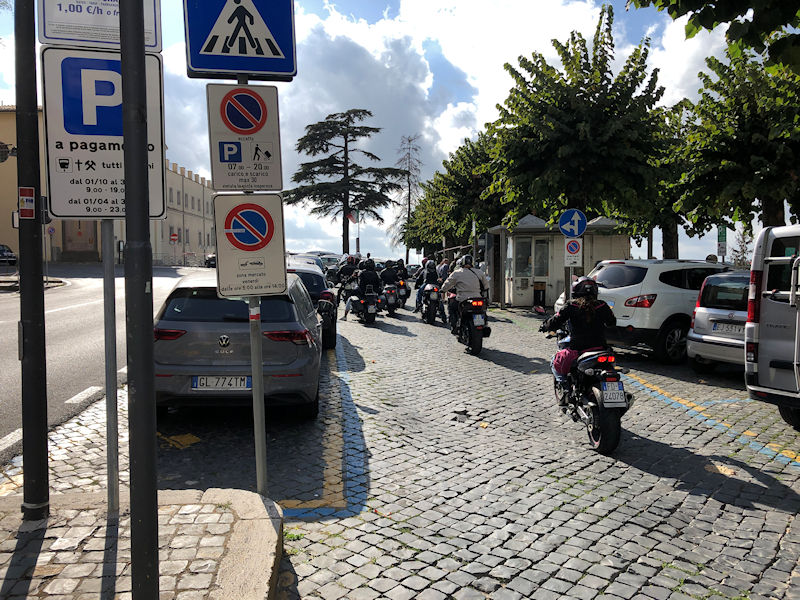
Masses of cars are being waved into the carpark for some imminent event -- even a troupe of Thunder Rollers lining up for the fun.
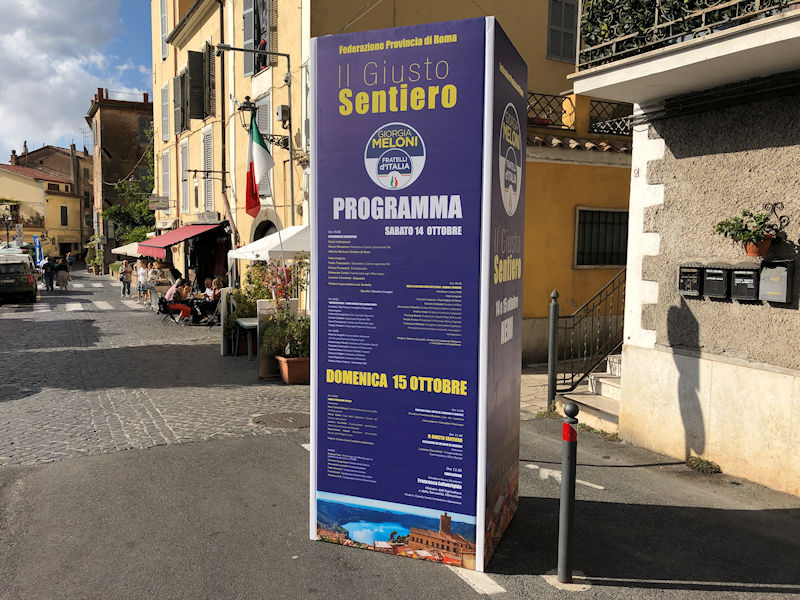
So what's this 'The Right Path' stuff all about? Giorgia Meloni!!! The Fratelli d'Italia! It's a bloody Far Right Rally, and going on into tomorrow, too!
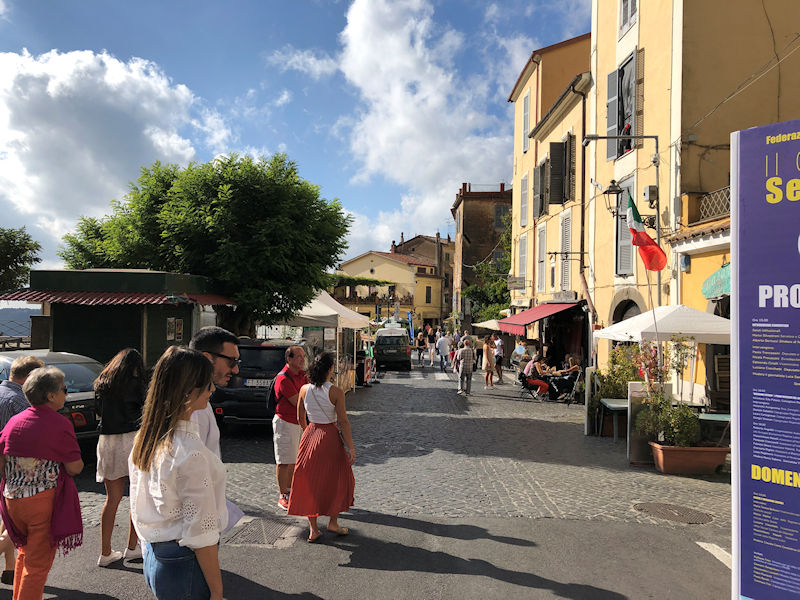
We've got to get out of here before it gets rough.
The lady in the florist shop here is calling our favorite taxi driver to come back for us.

Our taxi lady may have saved us from a very unpleasant experience.
(But at least the Far Righters here are unlikely to have brought their AR-15s.)
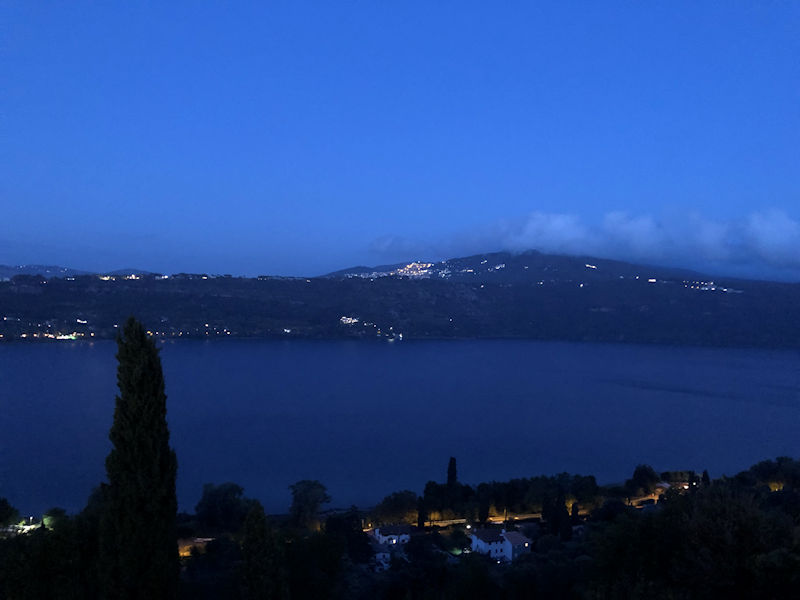
So we're back at the Ristorante Pagnanelli for another splendid repast, capped by a few Da Capo amaros (the best amaro, surely: 'distilled from sugar beets, then macerated with 29 herbs, spices, roots, fruits, and flowers from Southern Italy').

If another good reason were needed to visit Italy, how about this one?
Next up: A visit to the Sunday street market in Rome


 Dwight Peck's personal website
Dwight Peck's personal website

















































































